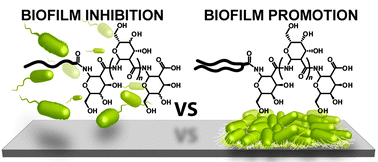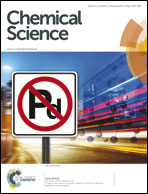Synthesis of bioinspired carbohydrate amphiphiles that promote and inhibit biofilms†
Abstract
The synthesis and characterization of a new class of bioinspired carbohydrate amphiphiles that modulate Pseudomonas aeruginosa biofilm formation are reported. The carbohydrate head is an enantiopure poly-amido-saccharide (PAS) prepared by a controlled anionic polymerization of β-lactam monomers derived from either glucose or galactose. The supramolecular assemblies formed by PAS amphiphiles are investigated in solution using fluorescence assays and dynamic light scattering. Dried samples are investigated using X-ray diffraction, infrared spectroscopy, and transmission electron microscopy. Additionally, the amphiphiles are evaluated for their ability to modulate biofilm formation by the Gram-negative bacterium Pseudomonas aeruginosa. Remarkably, from a library of eight amphiphiles, we identify a structure that promotes biofilm formation and two structures that inhibit biofilm formation. Using biological assays and electron microscopy, we relate the chemical structure of the amphiphiles to the observed activity. Materials that modulate the formation of biofilms by bacteria are important both as research tools for microbiologists to study the process of biofilm formation and for their potential to provide new drug candidates for treating biofilm-associated infections.


 Please wait while we load your content...
Please wait while we load your content...